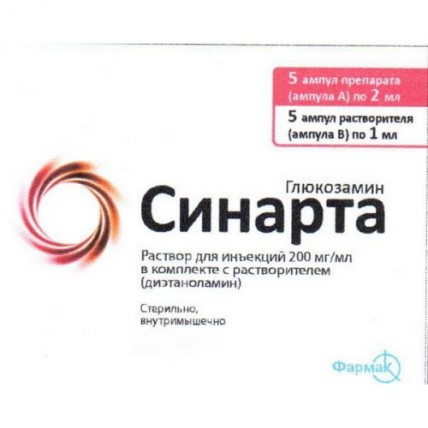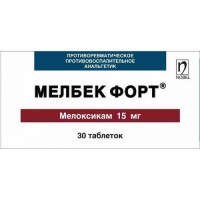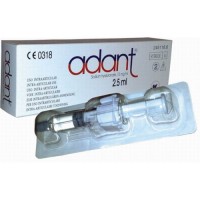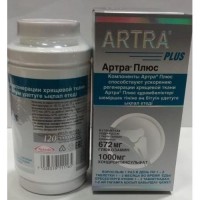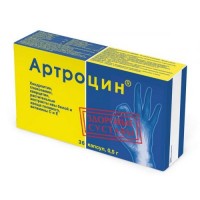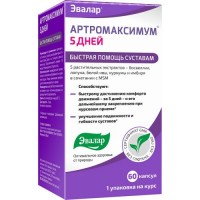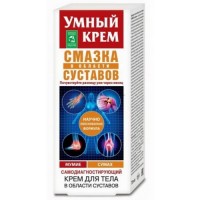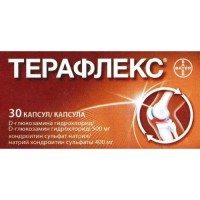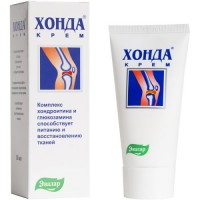Sinarta 200 mg / ml solution for injection 5's together with the solvent
- $47.60
The instruction for medical use
of SINARTA medicine
the Trade name
of Sinart Mezhdunarodnoye the unlicensed
name Glycosamine Dosage Form Solution for injections of 200 mg/ml on 2 ml, complete with solvent (diethanol amide) on 1 ml
Structure
of 1 ml of drug (an ampoule A) contains
active agent: a sulfate glycosamine sodium salt in terms of 100% substance - 251.25 mg, in terms of a glycosamine sulfate - 200 mg, in terms of sodium chloride - 51.25 mg,
excipients: lidocaine a hydrochloride, water for injections.
(An ampoule C) diethanol amide, water for injections contains 1 ml of solvent.
Description
Ampoule And: transparent colourless or light yellow color liquid.
An ampoule In: transparent colourless liquid.
An ampoule And + In: transparent colourless or light yellow color liquid.
Pharmacotherapeutic group
Nonsteroid anti-inflammatory and antirheumatic drugs.
Other non-steroidal anti-inflammatory drugs. Glycosamine.
The ATX M01AX05 code
the Pharmacological
Pharmacokinetics Later properties of intramuscular introduction of a glycosamine quickly passes sulfate through biological barriers and gets into fabrics, mainly articulate cartilage. Elimination half-life − about 60 hours, is removed generally by kidneys.
The Glycosamine pharmacodynamics sulfate stimulates synthesis of glikozaminoglikan and, respectively, articulate proteoglycans. Besides, the glycosamine shows anti-inflammatory properties, slows down processes of degradation of an articulate cartilage mainly due to its metabolic activities, ability to oppress activity of interleukin-1 (IL-1), lizosomalny enzymes, collagenases and phospholipases of A2.
The effect of treatment of a glycosamine is shown by sulfate in 2-3 weeks from an initiation of treatment.
Indications
– treatment of symptoms of an osteoarthritis: pain and functional limitation
the Route of administration and doses
use Drug only intramusculary.
Adult patients and patients of advanced age.
Before use to mix solution In (solvent) with solution A (drug solution) in one syringe. The prepared solution of drug is entered intramusculary on 3 ml (A+ solution B) by 3 times a week in 1 day within 4-6 weeks.
Side effects
Often
– a stomach ache, a meteorism, diarrhea, a constipation, nausea, vomiting
– a headache, drowsiness, the general weakness, increased fatigue
Infrequently
– an erythema
Very seldom
– anaphylactoid reactions, an acute anaphylaxis, generalized exfoliative dermatitis
In isolated cases
– numbness of language and lips, a photophobia, a sleep disorder, disorders of vision, a diplopia, confusion of consciousness, muscular twitchings, after use of high doses – sonitus, the excited state, paresthesias, spasms
– arterial hypotension, cross heart block
– hypostasis
– respiratory depression or an apnoea, short wind
– feeling of heat, cold or numbness of extremities, a malignant hyperthermia, oppression of the immune system
– feeling of easy burning (disappears with development of the anesthetizing effect within 1 minute), thrombophlebitis, pain on the site of an injection
the Communication is not proved
– allergic reaction in the form of various skin rashes and an itching
– a visual disturbance
–
the Contraindication hair loss
– individual hypersensitivity to a glycosamine to sulfate, lidocaine and auxiliary components of drug
– an allergy on mollusks,
– cardiogenic shock
– the profound arterial hypotension
– severe forms of chronic heart failure
– reduced function of a left ventricle
– atrioventricular block ІІ-ІІІ degree
– heavy bradycardia
– Adams-Stokes's syndrome
– the spasms in the anamnesis caused by lidocaine use
– a sick sinus syndrome
– heavy abnormal liver functions
– a hypovolemia
– a myasthenia
– children's age up to 18 years
– pregnancy and the period of a lactation
Medicinal interaction
not to mix seafood in one syringe with other drugs. Not to use other solvents besides which is applied.
Drug is compatible to non-steroidal anti-inflammatory drugs and glucocorticosteroids.
At combined use with coumarinic anticoagulants strengthening of their action is possible. In this connection at these patients it is reasonable to carry out control of parameters of coagulation.
Strengthening of gastrointestinal absorption of tetracycline is possible.
Cimetidinum, peptidin, bupivacaine, propranolol, quinidine, Disopyramidum, amitriptyline, nortriptilin, Chlorpromazinum, Imipraminum increase lidocaine level in blood serum, reducing his hepatic metabolism.
Lidocaine can strengthen effect of the drugs blocking neuromuscular transmission as the last reduce conductivity of nervous impulses.
At simultaneous use to antiarrhytmic drugs _a a class (including to quinidine, procaineamide, Disopyramidum) there is a lengthening of an interval of QT, in isolated cases the development of AV blockade or fibrillation of ventricles is possible.
At simultaneous use with sedativny means the soothing effect amplifies. Phenytoinum strengthens cardiodepressive effect of lidocaine.
At simultaneous use with procaineamide the nonsense, hallucinations are possible.
Ethanol strengthens the oppressing effect of lidocaine on a respiratory system.
Special instructions
Before use need to be carried out skin test on individual sensitivity because of contents as a part of lidocaine drug. It is necessary to appoint carefully drug sick, inclined to a malignant hyperthermia.
Before use of lidocaine in heart diseases it is necessary to normalize potassium level in blood (the hypopotassemia reduces efficiency of lidocaine).
It is necessary to observe extra care at drug use to patients with a circulatory unefficiency, arterial hypotension, abnormal liver functions and/or kidneys. It is also necessary to be careful at Sinarta's appointment to patients of advanced age, patients with epilepsy, in cardiac conduction abnormality, at respiratory insufficiency.
It is necessary to apply with care to patients with intolerance of glucose. During an initial stage of therapy the regular control of level of sugar in blood is necessary for patients with diabetes.
With care to use drug at treatment of patients with bronchial asthma.
One dose of medicine contains 40.3 mg of sodium. It should be considered when assigning to patients to whom the rigid saltless diet is shown.
Features of influence of drug on ability to run the vehicle and potentially dangerous mechanisms
of the Research concerning impact of drug on ability to drive the car and other mechanisms were not carried out.
It is necessary to be careful at control of vehicles and performance of work which require attention, in case of drowsiness or disorders of vision.
Overdose
Cases of overdose of a glycosamine of sulfate were not noted. In cases of overdose it is necessary to carry out the symptomatic treatment directed to recovery of water and electrolytic balance.
Excipient lidocaine is a part of an injection form of drug. Numbness of language and lips, the excited state, alarm, sonitus, dizziness, illegibility of sight, a tremor, a depression, drowsiness can be the first symptoms of overdose of lidocaine of a hydrochloride from the central nervous system. Symptomatic treatment is also directed to maintenance of the vital functions of an organism.
The form of release and packing
On 2 ml of drug spill in an ampoule from brown transparent glass with a break ring (or a break point) with a capacity of 3 ml (an ampoule A).
On 1 ml of solvent spill in an ampoule from colourless transparent glass with a break ring (or a break point) (an ampoule C).
On ampoules self-adhesive paste labels.
On 5 ampoules And (with drug) and on 5 ampoules In (with solvent) put in blister strip packagings from a film polymeric, respectively.
On 1 planimetric packing with ampoules And yes on 1 planimetric packing with ampoules In together with the instruction for medical use in the state and Russian languages put in a pack from cardboard.
To Store storage conditions in the place protected from light at a temperature not above 25 °C.
To store out of children's reach!
The period of storage
the Prepared solution should be applied 2 years at once.
Not to use drug after the termination of the expiration date specified on packing.
Prescription status
According to the prescription
PJSC Pharmak Producer, Ukraine, 04080, Kiev, st. of Frunze, 63.
The owner of the registration certificate
of PJSC Pharmak, Ukraine
the Address of the organization accepting in the territory of the Republic of Kazakhstan claims from consumers on quality of products (goods) the Republic of Kazakhstan, 050009 Almaty, st. of Abay 157, office 5tel/fax: +7 (727) 250 66 23, the e-mail address:
To Develop Djatlova88@mail.ru
of SINARTA medicine
the Trade name
of Sinart Mezhdunarodnoye the unlicensed
name Glycosamine Dosage Form Solution for injections of 200 mg/ml on 2 ml, complete with solvent (diethanol amide) on 1 ml
Structure
of 1 ml of drug (an ampoule A) contains
active agent: a sulfate glycosamine sodium salt in terms of 100% substance - 251.25 mg, in terms of a glycosamine sulfate - 200 mg, in terms of sodium chloride - 51.25 mg,
excipients: lidocaine a hydrochloride, water for injections.
(An ampoule C) diethanol amide, water for injections contains 1 ml of solvent.
Description
Ampoule And: transparent colourless or light yellow color liquid.
An ampoule In: transparent colourless liquid.
An ampoule And + In: transparent colourless or light yellow color liquid.
Pharmacotherapeutic group
Nonsteroid anti-inflammatory and antirheumatic drugs.
Other non-steroidal anti-inflammatory drugs. Glycosamine.
The ATX M01AX05 code
the Pharmacological
Pharmacokinetics Later properties of intramuscular introduction of a glycosamine quickly passes sulfate through biological barriers and gets into fabrics, mainly articulate cartilage. Elimination half-life − about 60 hours, is removed generally by kidneys.
The Glycosamine pharmacodynamics sulfate stimulates synthesis of glikozaminoglikan and, respectively, articulate proteoglycans. Besides, the glycosamine shows anti-inflammatory properties, slows down processes of degradation of an articulate cartilage mainly due to its metabolic activities, ability to oppress activity of interleukin-1 (IL-1), lizosomalny enzymes, collagenases and phospholipases of A2.
The effect of treatment of a glycosamine is shown by sulfate in 2-3 weeks from an initiation of treatment.
Indications
– treatment of symptoms of an osteoarthritis: pain and functional limitation
the Route of administration and doses
use Drug only intramusculary.
Adult patients and patients of advanced age.
Before use to mix solution In (solvent) with solution A (drug solution) in one syringe. The prepared solution of drug is entered intramusculary on 3 ml (A+ solution B) by 3 times a week in 1 day within 4-6 weeks.
Side effects
Often
– a stomach ache, a meteorism, diarrhea, a constipation, nausea, vomiting
– a headache, drowsiness, the general weakness, increased fatigue
Infrequently
– an erythema
Very seldom
– anaphylactoid reactions, an acute anaphylaxis, generalized exfoliative dermatitis
In isolated cases
– numbness of language and lips, a photophobia, a sleep disorder, disorders of vision, a diplopia, confusion of consciousness, muscular twitchings, after use of high doses – sonitus, the excited state, paresthesias, spasms
– arterial hypotension, cross heart block
– hypostasis
– respiratory depression or an apnoea, short wind
– feeling of heat, cold or numbness of extremities, a malignant hyperthermia, oppression of the immune system
– feeling of easy burning (disappears with development of the anesthetizing effect within 1 minute), thrombophlebitis, pain on the site of an injection
the Communication is not proved
– allergic reaction in the form of various skin rashes and an itching
– a visual disturbance
–
the Contraindication hair loss
– individual hypersensitivity to a glycosamine to sulfate, lidocaine and auxiliary components of drug
– an allergy on mollusks,
– cardiogenic shock
– the profound arterial hypotension
– severe forms of chronic heart failure
– reduced function of a left ventricle
– atrioventricular block ІІ-ІІІ degree
– heavy bradycardia
– Adams-Stokes's syndrome
– the spasms in the anamnesis caused by lidocaine use
– a sick sinus syndrome
– heavy abnormal liver functions
– a hypovolemia
– a myasthenia
– children's age up to 18 years
– pregnancy and the period of a lactation
Medicinal interaction
not to mix seafood in one syringe with other drugs. Not to use other solvents besides which is applied.
Drug is compatible to non-steroidal anti-inflammatory drugs and glucocorticosteroids.
At combined use with coumarinic anticoagulants strengthening of their action is possible. In this connection at these patients it is reasonable to carry out control of parameters of coagulation.
Strengthening of gastrointestinal absorption of tetracycline is possible.
Cimetidinum, peptidin, bupivacaine, propranolol, quinidine, Disopyramidum, amitriptyline, nortriptilin, Chlorpromazinum, Imipraminum increase lidocaine level in blood serum, reducing his hepatic metabolism.
Lidocaine can strengthen effect of the drugs blocking neuromuscular transmission as the last reduce conductivity of nervous impulses.
At simultaneous use to antiarrhytmic drugs _a a class (including to quinidine, procaineamide, Disopyramidum) there is a lengthening of an interval of QT, in isolated cases the development of AV blockade or fibrillation of ventricles is possible.
At simultaneous use with sedativny means the soothing effect amplifies. Phenytoinum strengthens cardiodepressive effect of lidocaine.
At simultaneous use with procaineamide the nonsense, hallucinations are possible.
Ethanol strengthens the oppressing effect of lidocaine on a respiratory system.
Special instructions
Before use need to be carried out skin test on individual sensitivity because of contents as a part of lidocaine drug. It is necessary to appoint carefully drug sick, inclined to a malignant hyperthermia.
Before use of lidocaine in heart diseases it is necessary to normalize potassium level in blood (the hypopotassemia reduces efficiency of lidocaine).
It is necessary to observe extra care at drug use to patients with a circulatory unefficiency, arterial hypotension, abnormal liver functions and/or kidneys. It is also necessary to be careful at Sinarta's appointment to patients of advanced age, patients with epilepsy, in cardiac conduction abnormality, at respiratory insufficiency.
It is necessary to apply with care to patients with intolerance of glucose. During an initial stage of therapy the regular control of level of sugar in blood is necessary for patients with diabetes.
With care to use drug at treatment of patients with bronchial asthma.
One dose of medicine contains 40.3 mg of sodium. It should be considered when assigning to patients to whom the rigid saltless diet is shown.
Features of influence of drug on ability to run the vehicle and potentially dangerous mechanisms
of the Research concerning impact of drug on ability to drive the car and other mechanisms were not carried out.
It is necessary to be careful at control of vehicles and performance of work which require attention, in case of drowsiness or disorders of vision.
Overdose
Cases of overdose of a glycosamine of sulfate were not noted. In cases of overdose it is necessary to carry out the symptomatic treatment directed to recovery of water and electrolytic balance.
Excipient lidocaine is a part of an injection form of drug. Numbness of language and lips, the excited state, alarm, sonitus, dizziness, illegibility of sight, a tremor, a depression, drowsiness can be the first symptoms of overdose of lidocaine of a hydrochloride from the central nervous system. Symptomatic treatment is also directed to maintenance of the vital functions of an organism.
The form of release and packing
On 2 ml of drug spill in an ampoule from brown transparent glass with a break ring (or a break point) with a capacity of 3 ml (an ampoule A).
On 1 ml of solvent spill in an ampoule from colourless transparent glass with a break ring (or a break point) (an ampoule C).
On ampoules self-adhesive paste labels.
On 5 ampoules And (with drug) and on 5 ampoules In (with solvent) put in blister strip packagings from a film polymeric, respectively.
On 1 planimetric packing with ampoules And yes on 1 planimetric packing with ampoules In together with the instruction for medical use in the state and Russian languages put in a pack from cardboard.
To Store storage conditions in the place protected from light at a temperature not above 25 °C.
To store out of children's reach!
The period of storage
the Prepared solution should be applied 2 years at once.
Not to use drug after the termination of the expiration date specified on packing.
Prescription status
According to the prescription
PJSC Pharmak Producer, Ukraine, 04080, Kiev, st. of Frunze, 63.
The owner of the registration certificate
of PJSC Pharmak, Ukraine
the Address of the organization accepting in the territory of the Republic of Kazakhstan claims from consumers on quality of products (goods) the Republic of Kazakhstan, 050009 Almaty, st. of Abay 157, office 5tel/fax: +7 (727) 250 66 23, the e-mail address:
To Develop Djatlova88@mail.ru
